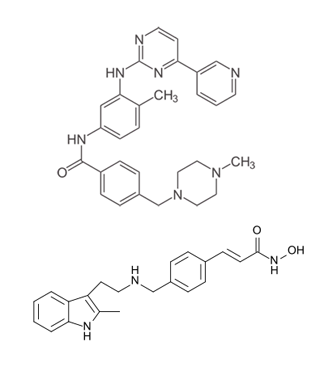HDAC Inhibitor and Imatinib Combo May Inhibit GIST Growth
Patients with heavily pretreated metastatic gastrointestinal stromal tumors were able to tolerate combined treatment with the pan-deacetylase inhibitor panobinostat and imatinib, according to the results of a small phase I study.
Chemical structures of imatinib (top) and panobinostat (bottom)

Patients with heavily pretreated metastatic gastrointestinal stromal tumors were able to tolerate combined treatment with the pan-deacetylase inhibitor panobinostat and imatinib, according to the results of a small phase I study.
“This proof-on-concept study shows that a combination of an HDAC [hydroxamic acid inhibitor of histone deacetylases]-inhibitor and imatinib may stop GIST from growing, just as the preclinical studies have suggested,” study author Sebastian Bauer, MD, of the University Duisburg-Essen, Germany, told Cancer Network.
Despite the success of imatinib in significantly improving the survival of patients with GIST, most patients will eventually progress; therefore, finding novel treatments to further delay tumor growth in these patients is a priority. Previously, researchers have preclinically evaluated the activity of different classes of HDAC in patients with GIST.
“The pan-HDACi panobinostat (LBH589) potently inhibited the growth of GIST cell lines in vitro (IC50 values between 80 and 100 nM),” the researchers wrote. “Interestingly, panobinostat activity was only seen in KIT-positive GIST models indicating target specificity.”
Given these encouraging results, Bauer and colleagues conducted a phase I study of 12 heavily pretreated patients aged 18 years or older with metastatic GIST. Patients underwent a 7-day run-in phase of imatinib at 400 mg per day, and then escalating doses of panobinostat were added using a “3 plus 3” design. The results of their study were published in the British Journal of Cancer.
Maximum tolerated dose was identified as 20 mg of panobinostat and 400 mg imatinib. The most commonly reported adverse events were thrombocytopenia, anemia, fatigue, creatinine elevation, nausea, emesis, and diarrhea.
Upon evaluation conducted after 3 weeks panobinostat treatment, 1 patient of 11 had metabolic partial response, 7 had metabolically stable disease, and 3 patients had disease progression.
“Most notably, in a bed-to-bench approach we have used the PK-findings from this trial to investigate the pharmacodynamics in vitro,” Bauer said. “In these experiments, we have shown that this combination may inhibit even the most resistant KIT D816 secondary mutations.”
Bauer said that although the delays in progression seen in this trial were encouraging, most were short lived.
“However, patients in this trial had been heavily pretreated and had mostly very advanced disease,” Bauer said. “We have shown that panobinostat has a disease-specific mechanism of action in GIST, as it inhibits KIT. Optimizing the GIST-specific dosing schedule and possible additional combination partners will be our next steps.”
Newsletter
Stay up to date on recent advances in the multidisciplinary approach to cancer.